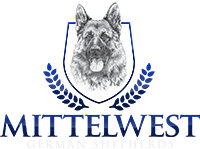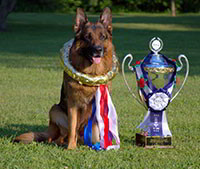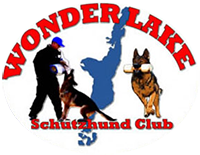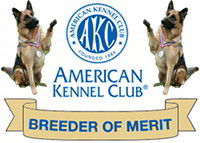Summary:
Long-haired German Shepherd training changes with age. From gentle neonatal handling to advanced adult work, each stage builds skills and trust. Stay consistent, match training to maturity, and you’ll raise a steady, loyal companion.
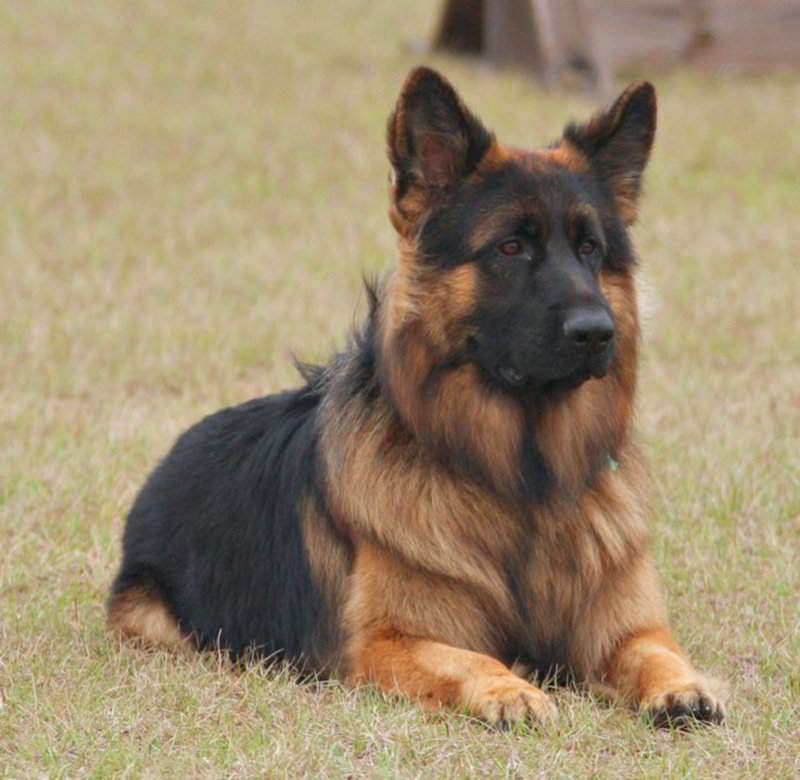
Long-haired German Shepherds combine beauty, intelligence, and loyalty. With the right structure, they can excel as family companions, protectors, and working dogs.
However, training isn’t one-size-fits-all. It changes with age, energy level, and maturity. Here’s how Mittelwest raises dogs with confidence and control from day one, and how you can follow the same path.
Neonatal Stage (0–3 Weeks)
This stage is the beginning. Puppies can’t see or hear yet. Their only world is warmth, scent, and their mother’s care.
Human handling is short, soft, and purposeful, just enough to create early trust. Too much stress now can create lasting nervousness later.
The real “training” here is environmental. Clean bedding, steady warmth, and zero chaos build a sense of safety that lasts.
Key goals:
- Keep the whelping area warm, clean, and calm.
- Minimal, gentle human touch to start bonding.
- Support the mother so she can care for her litter without interruption.
Early security is everything. A calm, safe start builds the trust your Shepherd will lean on for the rest of their life, making every future training stage easier and more effective.
Transitional Stage (3–4 Weeks)
Eyes open. Ears start working. Wobbly steps turn into short, curious explorations.
Now, puppies begin to recognize voices and scents. Play with littermates starts shaping their instincts. Human interaction becomes meaningful.
Training still isn’t about commands, it’s about letting them explore without overwhelm. Small, positive moments lay the groundwork for trust and confidence.
Key goals:
- Encourage gentle exploration.
- Keep interactions short and positive.
- Begin light handling from multiple people to build comfort with humans.
This stage is where curiosity meets safety. Support exploration without overload, and you’ll build a Shepherd that steps into each new stage with growing confidence and trust in people.
Socialization Stage (4–12 Weeks)
This phase is the most important window in a Shepherd’s life. What they learn here shapes their view of the world forever.
Start basic obedience, sit, come, down, with a happy voice and rewards. Add crate training, housebreaking, and short leash walks.
Expose them to sidewalks, friendly strangers, and harmless noises. Keep it positive. Don’t push; confidence builds with repetition and predictability.
Key goals:
- Introduce new people, places, and sounds safely.
- Start crate training, housebreaking, and leash manners.
- Build confidence through positive repetition.
Socialization is the foundation of a balanced Shepherd. Positive exposure now prevents fear and reactivity later, creating a confident dog ready to take on the world with you.
Juvenile Stage (3–6 Months)
The sponge phase ends. Independence kicks in. Teething peaks, and chewing becomes a hobby.
Keep sessions short but consistent. Reinforce basics, add leash manners, and introduce rules like calm greetings and waiting at doors.
Redirect chewing instead of scolding. Stay calm. Shepherds respond best to clear guidance, not frustration.
Key goals:
- Keep structure and training consistent.
- Strengthen recall and leash manners.
- Redirect unwanted chewing with appropriate toys.
This stage can be messy, but it’s where good habits take root. Consistent structure now creates a Shepherd who respects boundaries and thrives under your leadership.
Adolescence Stage (6–18 Months)
Think of this as the Shepherd “teenage” phase. Hormones rise, energy spikes, and rules get tested.
Stay firm and consistent. Add distractions to training, practice “stay” at the park, or “come” while another dog walks by.
Consider group obedience classes for structure and challenge. Without it, bad habits stick.
Key goals:
- Keep rules consistent despite testing behavior.
- Train in distracting environments.
- Maintain leadership and boundaries.
Adolescence tests your patience, but it’s also where loyalty deepens. Clear rules and a daily structure guide your Shepherd through the chaos into maturity.
Young Adult Stage (18–24 Months)
Your Shepherd is stronger, steadier, and more focused. This period is prime time for advanced work, tracking, scent detection, agility, or protection sports.
Polish earlier commands until they’re automatic. Add distance, duration, and complexity. Keep their mind as active as their body.
Key goals:
- Advance to specialty skills and complex commands.
- Maintain mental and physical challenge.
- Continue varied socialization to prevent boredom.
This stage blends power with focus. Training now can shape a Shepherd who’s not just obedient, but skilled, adaptable, and ready for real-world work.
Adult Stage (2–3 Years)
You now have the finished product, physically strong, mentally steady, and fully capable.
Training is about reinforcement, not introduction. Keep commands sharp, but also mix in new skills to keep them adaptable.
Consider therapy certification, search-and-rescue work, or canine sports to keep the purpose alive.
Key goals:
- Maintain training through daily reinforcement.
- Add new challenges to keep skills fresh.
- Keep social experiences varied.
A well-trained adult Shepherd is confident and capable. Ongoing challenges keep their mind sharp and their bond with you unshakable.
Specialized Training: Turning Skills Into Mastery
Once the basics are second nature, specialty training channels a Shepherd’s natural drive.
Schutzhund/IGP: Tracking, Obedience, & Protection In One Sport
Schutzhund challenges a German Shepherd’s mind and body. It develops discipline, control, and drive while preserving original working abilities through structured, competitive tracking, obedience, and controlled protection exercises.
Scent Work: Perfect For Search & Rescue Or Detection
Scent work taps into a Shepherd’s incredible nose. Dogs learn to locate specific scents, aiding in search-and-rescue missions, detection work, or sport competitions. It also provides mental enrichment and purposeful activity every session.
Therapy Or Service Work: Uses Calm, Disciplined Temperaments
Therapy and service work channel a Shepherd’s stability and focus into life-changing tasks. From guiding handlers to providing comfort, these roles require training, empathy, and a calm, people-oriented temperament.
Choose a path that matches your dog’s temperament and your lifestyle. Specialty work gives German Shepherds purpose, challenge, and pride.
Specialized training turns a good Shepherd into a great one. Purpose-driven work taps into their instincts, creating a dog that thrives on skill, trust, and teamwork.
Maintaining Training Consistency Over A Lifetime
Training doesn’t end once your Shepherd “knows it.” Skills fade without practice, and routines can slip if you’re not intentional.
Set aside daily time for short training refreshers. Keep the rules the same across all family members. Switch up the environment now and then, practicing “stay” in the backyard feels different than in a crowded park.
Consistency isn’t about drilling commands endlessly; it’s about reinforcing habits in a way that fits everyday life.
Lifelong consistency keeps your Shepherd sharp, confident, and reliable. Without it, training fades. With it, skills remain second nature, and your bond stays strong no matter how many years pass.
Common Mistakes To Avoid In Each Stage
Every stage has traps that owners can fall into.
- Neonatal: Too much handling too soon.
- Socialization: Overwhelming the puppy with too much too fast.
- Juvenile: Inconsistent rules and letting bad habits slide.
- Adolescence: Backing off training when it feels “too hard.”
- Adult: Stopping structured work because the dog “knows enough.”
Knowing these pitfalls means you can sidestep them and keep your Shepherd on track from day one.
Avoiding stage-specific mistakes protects your training investment. With awareness and patience, you’ll navigate each milestone smoothly, turning potential setbacks into opportunities for stronger skills and deeper trust.
How Mittelwest Sets Dogs Up For Success
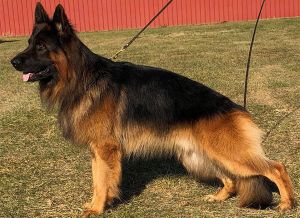
At Mittelwest German Shepherds, training starts at birth. Our dogs come from proven bloodlines with structure, health care, and socialization from day one.
We start every puppy’s journey with early socialization long before they leave our care. From the moment they’re born, we expose our pups to people, sounds, and safe environments that build confidence and adaptability.
Our breeding program uses only health-tested parents with transparent records. We plan every pairing to preserve the German Shepherd’s structure, temperament, and genetic health. So you know exactly what’s behind your puppy.
We offer training programs that grow with your dog. From puppy basics to advanced protection work, we design each stage to build obedience, trust, and real-world skills.
For ongoing support, we provide professional grooming and secure boarding services. Whether you need routine coat care or a safe place for your Shepherd while you’re away, we’re here for the long term.
Our goal is simple: Shepherds that excel in real life, whether that’s at home, in sport, or in service.
Training a long-haired German Shepherd is a journey, not a sprint. Master each stage, and you’ll have a confident, capable partner for life.
